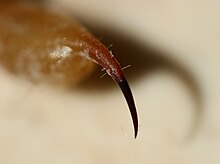Stinger

Astinger(orsting) is a sharporganfound in variousanimals(typicallyinsectsand otherarthropods) capable of injectingvenom,usually by piercing theepidermisof another animal.
Aninsectsting is complicated by its introduction ofvenom,although not all stings are venomous. Bites, which can introducesalivaas well as additional pathogens and diseases, are often confused with stings, and vice versa. Specific components of venom are believed to give rise to anallergic reaction,which in turn produces skin lesions that may vary from a small itching weal, or slightly elevated area of the skin, to large areas of inflamed skin covered byvesiclesand crustedlesions.
Stinging insects produce a painful swelling of the skin, the severity of the lesion varying according to the location of the sting, the identity of the insect and the sensitivity of the subject. Many species ofbeesandwaspshave two poison glands, one gland secreting atoxinin whichformic acidis one recognized constituent, and the other secreting analkalineneurotoxin;acting independently, each toxin is rather mild, but when they combine through the sting, the combination has strong irritating properties. In a small number of cases, the second occasion of a bee or wasp sting causes a severe allergic reaction known asanaphylaxis.[1]
While the overwhelming majority of insects withdraw their stingers from their victims, a few insects leave them in the wounds. For example, of the 20,000 species of bees worldwide, only the half-dozen species of honeybees (Apis) are reported to have a barbed stinger that cannot be withdrawn; of wasps, nearly all are reported to have smooth stingers with the exception of two species,Polybia rejectaandSynoeca surinama.A few non-insect arthropods, such asscorpions,also sting.
Arthropods
[edit]
Amongarthropods,a sting or stinger is a sharp organ, often connected with a venom gland and adapted to inflict a wound by piercing, as with the caudal sting of ascorpion.Stings are usually located at the rear of the animal. Animals with stings include bees, wasps (includinghornets) andscorpions,[2][3]as well as a single beetle species (Onychocerus albitarsis) that can deliver a venomous sting from its antennae, whose terminal segments have evolved to resemble a scorpion's tail.[4]

In all stingingHymenopterathe sting is a modifiedovipositor.[5]Unlike most other stings,honey beeworkers' stings are strongly barbed and lodge in the flesh ofmammalsupon use, tearing free from the honey bee's body, killing the bee within minutes.[2]The sting has its ownganglion,and it continues to saw into the target's flesh and release venom for several minutes. This trait is of obvious disadvantage to the individual but protects the hive from attacks by large animals; aside from the effects of the venom, the remnant also marks the stung animal with honey bee alarm pheromone. The barbs of a honey bee's attack are only suicidal if the skin is elastic, as is characteristic of vertebrates such as birds and mammals; honey bees can sting other insects repeatedly without dying.[6]
The sting of nearly all other bees and other sting-bearing organisms is not barbed and can be used to sting repeatedly. The description of barbed or unbarbed is not precise: there are barbs on the stings ofyellowjacketwasps and theMexican honey wasp,but the barbs are so small that the wasp can sometimes withdraw its sting apparatus from victim's skin.[7]
The stings of some wasps, such as those of thePolistes versicolor,contain relatively large amounts of5-hydroxytryptamine(5-HT) in its venoms. The 5-HT in these venoms has been found to play at least two roles: one as a pain-producing agent and the other in the distribution and penetration of the paralyzing components to vulnerable sites in the offender. This helps in the rapid immobilization of the animal or of the body parts receiving the venom.[8]
Spiders only bite, although some tarantulas have barbed bristles calledurticating hairs.Certain caterpillars also have urticating hairs.Centipedesalso possess a venomous bite rather than a sting, inflicted with a highly modified first pair of legs, calledforcipules.
Other animals
[edit]Organs that perform similar functions in non-arthropods are often referred to as "stings". These organs include the modifieddermal denticleof thestingray,thevenomous spurson the hind legs of the maleplatypus,and thecnidocytetentaclesof thejellyfish.[9]
The termstingwas historically often used for thefangof asnake,[10]although this usage is uncommon today. Snakes are said, correctly, tobite,not sting.
See also
[edit]- Bee sting
- Cnidocyte
- Chelicerae
- Forcipule
- Insect bite
- Schmidt Sting Pain Index
- Starr sting pain scale
- Stinging plant
References
[edit]- ^Riches, KJ; Gillis, D; James, RA (2002). "An autopsy approach to bee sting-related deaths".Pathology.34(3): 257–62.doi:10.1080/00313020220131327.PMID12109787.S2CID20615755.
- ^abThomas Eisner; Maria Eisner; Melody Siegler (2005).Secret Weapons: Defences of Insects, Spiders, Scorpions, and other Many-legged Creatures.Harvard University Press.ISBN978-0-674-01882-2.
- ^"Oxford Dictionaries".oxforddictionaries.com.Archived fromthe originalon May 20, 2013.Retrieved21 January2015.
- ^Berkov, Amy; Rodríguez, Nelson; Centeno, Pedro (15 Nov 2007). "Convergent evolution in the antennae of a cerambycid beetle,Onychocerus albitarsis,and the sting of a scorpion ".Naturwissenschaften.95(3): 257–61.doi:10.1007/s00114-007-0316-1.PMID18004534.S2CID30226487.
- ^Shing, H.; Erickson, E. H. (1982)."Some ultrastructure of the honeybee (Apis melliferaL.) sting ".Apidologie.13(3): 203–213.doi:10.1051/apido:19820301.
- ^"How Bees Work".HowStuffWorks.2007-05-30.Retrieved2022-04-26.
- ^Greene, Albert; Breisch, Nancy; Golden, David; Kelly, Denise; Douglass, Larry."Sting Embedment and Avulsion in Yellowjackets (Hymenoptera: Vespidae): a Functional Equivalent to Autotomy".Oxford Academic.Entomological Society of America.Retrieved7 March2019.
- ^Welsh, John H., and Carolyn S. Batty. "5-Hydroxytryptamine Content of Some Arthropod Venoms and Venom-containing Parts." Toxic on 1.4 (1963): 165-70. Web.
- ^"sting: definition of sting in Oxford dictionary (American English) (US)".oxforddictionaries.com.Archived fromthe originalon January 7, 2013.
- ^Oxford English Dictionary, 2nd ed. "Sting... Applied also to the fang or venom-tooth (and erroneously to the forked tongue) of a poisonous serpent."
External links
[edit] Media related toStingersat Wikimedia Commons
Media related toStingersat Wikimedia Commons
